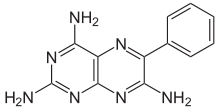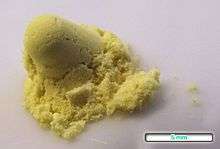Triamterene
 | |
 | |
| Clinical data | |
|---|---|
| Trade names | Dyrenium, Dyazide, Maxzide |
| AHFS/Drugs.com | Monograph |
| MedlinePlus | a682337 |
| Pregnancy category |
|
| Routes of administration | oral |
| ATC code | C03DB02 (WHO) |
| Legal status | |
| Legal status | |
| Pharmacokinetic data | |
| Bioavailability | 30-70% |
| Protein binding | 67% |
| Metabolism | conjugated to hydroxytriamterene |
| Biological half-life | 1-2 hours, active metabolite 3 hours |
| Excretion | renal <50%, 21% unchanged |
| Identifiers | |
| |
| CAS Number |
396-01-0 |
| PubChem (CID) | 5546 |
| IUPHAR/BPS | 4329 |
| DrugBank |
DB00384 |
| ChemSpider |
5345 |
| UNII |
WS821Z52LQ |
| KEGG |
D00386 |
| ChEMBL |
CHEMBL585 |
| ECHA InfoCard | 100.006.278 |
| Chemical and physical data | |
| Formula | C12H11N7 |
| Molar mass | 253.263 g/mol |
| |
| | |
Triamterene (trade name Dyrenium) is a potassium-sparing diuretic used in combination with thiazide diuretics for the treatment of hypertension and edema. In combination with hydrochlorothiazide, it is marketed under the names Maxzide and Dyazide.
Mechanism of action
Triamterene directly blocks the epithelial sodium channel[1] (ENaC) on the lumen side of the kidney collecting tubule.[2]:127 Other diuretics cause a decrease in the sodium concentration of the forming urine due to the entry of sodium into the cell via the ENaC, and the concomitant exit of potassium from the principal cell into the forming urine. Blocking ENaC prevents this from happening. Amiloride works in the same way. Sodium channel blockers directly inhibit the entry of sodium into the sodium channels.
Side effects
Common side effects may include a depletion of sodium, folic acid and calcium, nausea, vomiting, diarrhea, headache, dizziness, fatigue, and dry mouth. Serious side effects may include heart palpitations, tingling/numbness, fever, chills, sore throat, rash, and back pain. Triamterene can also cause kidney stones through direct crystallization or by seeding calcium oxalate stones. Triamterene is best avoided in patients with chronic kidney disease due to the possibility of hyperkalemia. People using this drug should use salt substitute cautiously.[3]
Triamterene may impart a blue fluorescent color to the urine.
Caution with certain disease states
Diabetes: Use with caution in patients with prediabetes or diabetes mellitus as there may be a change in glucose control.
Hepatic impairment: Use with caution in patients with severe hepatic dysfunction; in cirrhosis, avoid electrolyte and acid/base imbalances that might lead to hepatic encephalopathy.
Kidney stones: Use with caution in patients with kidney stones.
Use should be avoided if the creatinine clearance is less than 10 ml/minute.
With hydrochlorothiazide
Triamterene is commonly prepared in combination with hydrochlorothiazide for treatment of hypertension (high blood pressure) and edema (water retention). This combination is in a class of medications called diuretics or 'water pills', and causes the kidneys to get rid of the body's unneeded water and sodium through the urine.[4] Dyazide is marketed by GlaxoSmithKline and Maxzide is marketed by Mylan.
History
The triamterene ring system is found in many naturally occurring compounds, such as folic acid and riboflavin. The observation that the naturally occurring compound xanthopterin had renal affects led scientists at Smith Kline and French Laboratories in Philadelphia to begin a medicinal chemistry campaign to discover potential drugs, as part of a program to discover potassium-sparing diuretics.[2]:125 The first clinical studies were published in 1961 and the first trials combining it with hydrochlorothiazide were published the next year.[2]:126[5][6]
Smith Kline & French launched it as a single agent under the brand Dyrenium in 1964.[7]:83 The combination drug with hydrochlorothiazidem, Dyazide, was first approved in the US in 1965 and the first generic, brought by Bolar Pharmaceutical Co., was approved in 1987.[8][9] In 1986 Dyazide was the most prescribed drug in the US and had $325 million in sales, making it SmithKline Beckman's second-biggest seller behind Tagamet.[9]
The patents had expired on Dyazide in 1980, but complications arose with the introductions of generics, because the formulation of Dyazide resulted in variable batches that made it impossible for generic manufacturers to show that their versions were bioequivalent.[10][11]
Bolar Pharmaceutical was in the running to be the first to bring a generic, but its application was delayed by these concerns about whether its formulation provided the same amount of each drug; these were complicated by accusations that Bolar had fraudulently substituted Dyazide for its own version to conduct studies that were submitted to the FDA.[9] Shortly after Bolar's generic was approved, further concerns were raised with regard to Bolar's applications to market generics more generally; these findings among others raised widespread concern among doctors and the public over whether generics were really the same as branded drugs.[12][13] Bolar ended up recalling its generic form of Dyazide and withdrawing the product in 1990.[14] In 1991 the US Justice Department on behalf of the FDA filed 20 criminal charges against Bolar for its fraud,[15] and early the next year Bolar pled guilty and agreed to pay a $10M fine.[16] Public concern over the safety of generic drugs was further exacerbated by a Congressional investigation into bribery at the FDA by generics companies that found pervasive corruption; the investigation had been spurred by the generics company Mylan, which had hired private investigators based on its beliefs that competitors were getting unfair advantages in getting their generics approved.[17]
Mylan itself developed a version of a triamterene/hydrochlorothiazide combination drug after the Dyazide patent expired, and used a different, more stable formulation[11] as well as different dosages of each active ingredient (50 mg hydrochlorothiazide and 75 mg triamterene, compared with Dyazide's 25 mg hydrochlorothiazide and 50 mg triamterene) so it had to get approval as a new drug, as opposed to a generic; their product was called Maxzide and was approved in 1984.[18][19] The higher dose allowed once per day dosing, which Mylan and its marketing partner, Lederle, believed would help it compete against Dyazide, which had $210M in sales in 1983.[19]
Mylan's patents on the drug were declared invalid in court, and its marketing exclusivity expired in 1987, prompting a rush of generic competition and litigation by two of them, American Therapeutics Inc. and Vitarine Pharmaceuticals, with the FDA.[20] Vitarine, along wth Par Pharmaceutical, were two of the companies that Mylan had targeted in its investigation into corruption and it turned out that Par and Vitarine had each used Mylan's Maxzide to obtain its bioequivalence data, leading both companies to withdraw its generic competitor to Mylan's product.[17][21] Generics eventually entered the market.[22]
Research
While there is a lack of randomized controlled trials evaluating the use of triamterene in the treatment of Ménière's disease, the typical treatment is 37.5 mg of triamterene with 25 mg of hydrochlorothiazide 1–2 capsules daily.[23][24] This recommendation was given a Strength of Recommendation Taxonomy (SORT) grade of C.
References
- ↑ Busch AE; Suessbrich H; Kunzelmann K; et al. (September 1996). "Blockade of epithelial Na+ channels by triamterenes - underlying mechanisms and molecular basis". Pflugers Arch. 432 (5): 760–6. doi:10.1007/s004240050196. PMID 8772124.
- 1 2 3 Fink, Cynthia A; McKenna, Jeffrey M.; Werner, Lincoln H. (2003). "Diuretic and Uricosuric Agents". In Abraham, Donald J. Burger's medicinal chemistry and drug discovery. Volume 3: Cardiovascular Agents and Endocrines (6th ed. ed.). Wiley. pp. 55–154. ISBN 978-0471370291.
- ↑ LoSalt Advisory Statement (PDF) Archived December 10, 2005, at the Wayback Machine.
- ↑ "Triamterene and Hydrochlorothiazide". MedlinePlus. U.S. National Library of Medicine. National Institutes of Health. September 1, 2008.
- ↑ Crosley AP, et al. Triamterene, A New Natruretic Agent: Preliminary Observations in Man. Ann Intern Med. 1962;56:241-251. doi:10.7326/0003-4819-56-2-241 PMID 13882367
- ↑ Heath WC, Freis ED. Triamterene with Hydrochlorothiazide in the Treatment of Hypertension. JAMA. 1963 Oct 12;186:119-22. PMID 14056525
- ↑ Ralph Landau, Basil Achilladelis, Alexander Scriabine. Pharmaceutical Innovation: Revolutionizing Human Health. Volume 2 of Chemical Heritage Foundation series in innovation and entrepreneurship. Chemical Heritage Foundation, 1999 ISBN 9780941901215
- ↑ FDA Approval History NDA 016042: Dyazide. Page accessed Sept 8 2016
- 1 2 3 Ron Wolf for the Philadelphia Inquirer. August 22, 1987 Smithkline Loses Exclusive Rights To Drug
- ↑ Boehm, Garth; Yao, Lixin; Han, Liang; Zheng, Qiang (September 2013). "Development of the generic drug industry in the US after the Hatch-Waxman Act of 1984". Acta Pharmaceutica Sinica B. 3 (5): 297–311. doi:10.1016/j.apsb.2013.07.004.
- 1 2 John Seaman and John T. Landry. Mylan 50 Years of Unconventional Success. Mylan, in association with University Press of New England, 2011. ISBN 9781611682700. Page 50
- ↑ Strickland, Carol (15 October 1989). "Bolar: A Drug Company Under Siege". The New York Times.
- ↑ Cimons, Marlene (29 August 1989). "FDA to Lift OK of Last Dyazide Generic Version". Los Angeles Times.
- ↑ "Bolar Recalls Generic Version Of Dyazide And Extended Release Phenytoin, Saying "Bioequivalence Cannot Be Assured"; Products; Represent 52% of Sales". Pink Sheet. February 5, 1990.
- ↑ Shaw, Donna (February 27, 1991). "U.s. Charges Bolar Pharmaceutical With Misrepresenting Its Products". Philadelphia Inquirer.
- ↑ Freudenheim, Milt (28 February 1991). "Bolar Plans Guilty Plea On Generics". The New York Times.
- 1 2 Freudenheim, Milt (10 September 1989). "Exposing the F.D.A.". New York Times.
- ↑ FDA Approval History NDA 019129: Maxzide Page accessed Sept 8, 2016
- 1 2 Pink Sheet Oct 22, 1984 Mylan's Maxzide is "Approvable" at FDA: Lederle To Market Brand Competition to Smithkline's No. 3-Ranked Dyazide; Final Approval Anticipated "Imminently"
- ↑ Reid, Kenneth (November 17, 1987). "US Judge to Rule on Drug Marketing". Journal of Commerce.
- ↑ Andrews, Edmund L. (31 July 1989). "F.D.A. Inquiry on Generic Drugs Focuses on Changes in Ingredients". The New York Times.
- ↑ Drugs.com Generic Maxzide Page accessed Sept 8 2016
- ↑ Swartz R; Longwell P (March 2005). "Treatment of vertigo" (PDF). Am Fam Physician. 71 (6): 1115–22. PMID 15791890.
- ↑ Sloane PD; Coeytaux RR; Beck RS; Dallara J (May 2001). "Dizziness: state of the science". Ann. Intern. Med. 134 (9 Pt 2): 823–32. doi:10.7326/0003-4819-134-9_Part_2-200105011-00005. PMID 11346317.
External links
- Dyazide Prescribing Information GlaxoSmithKline